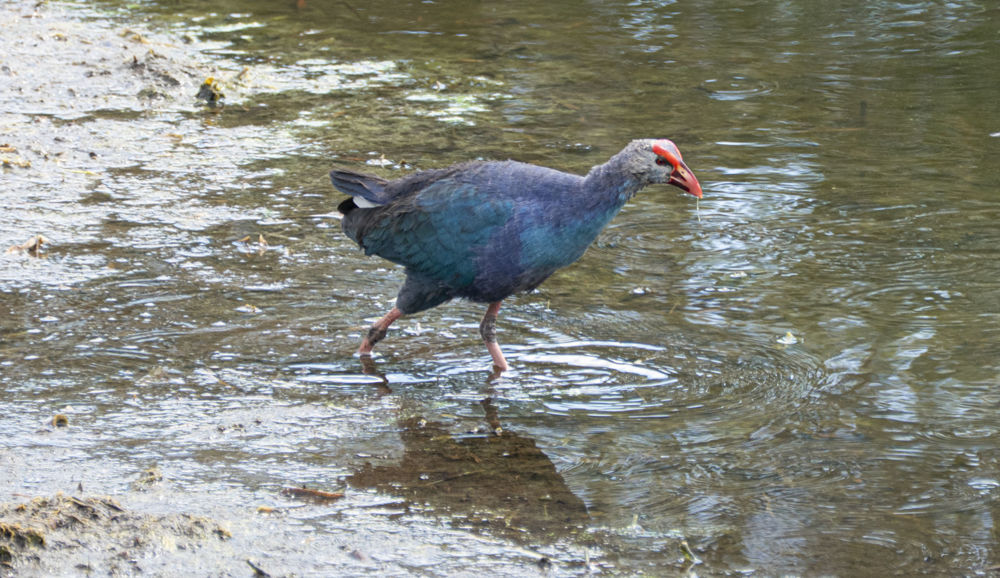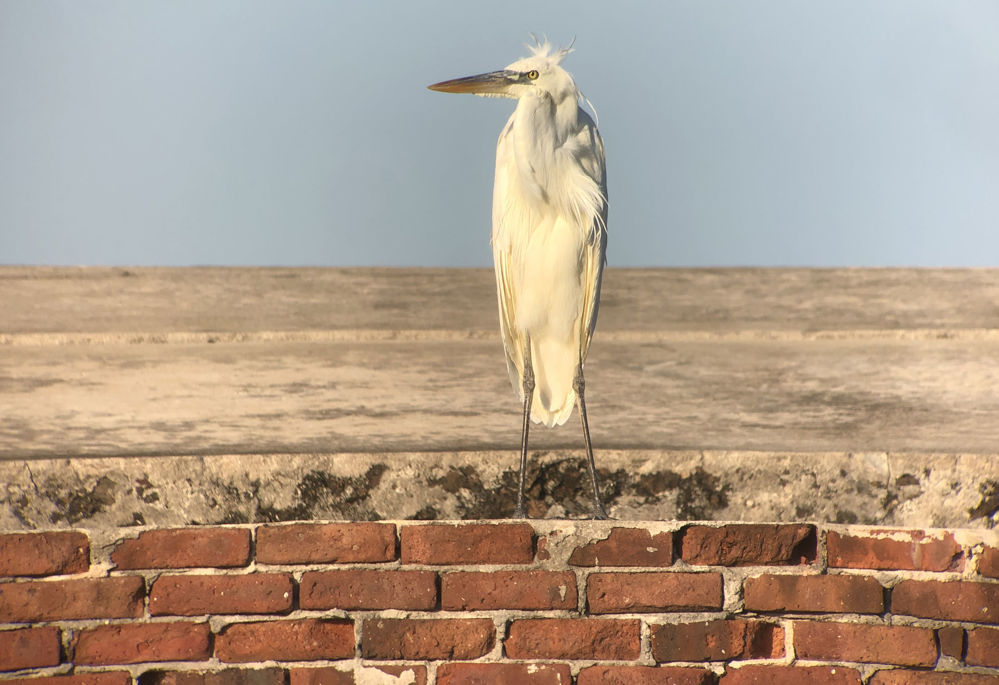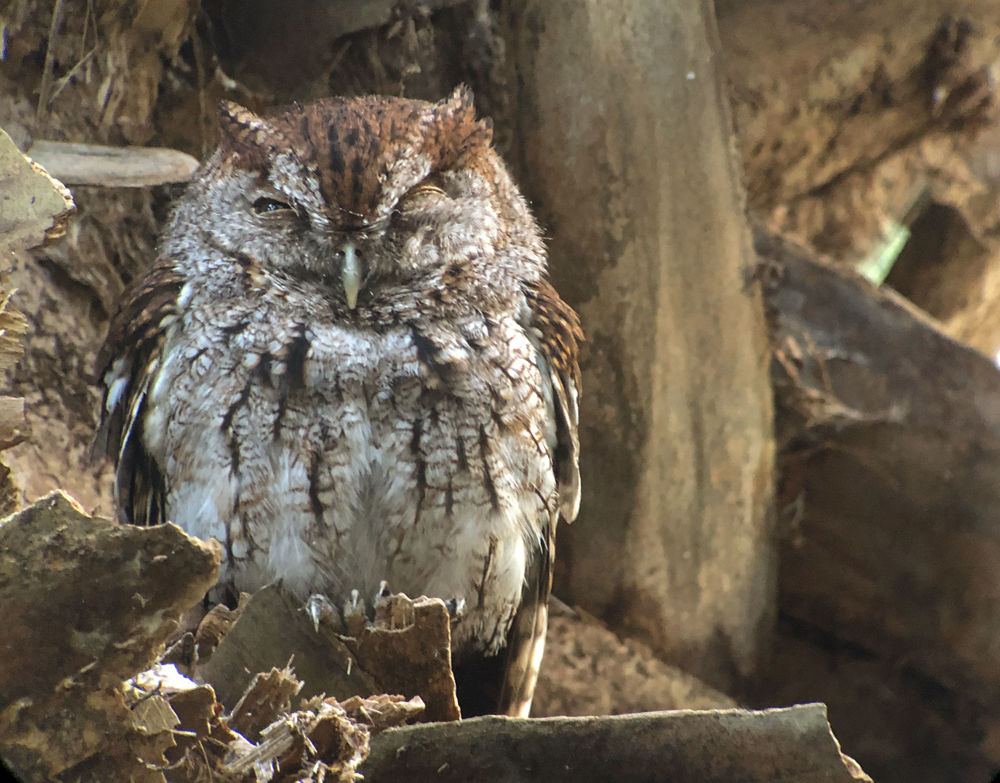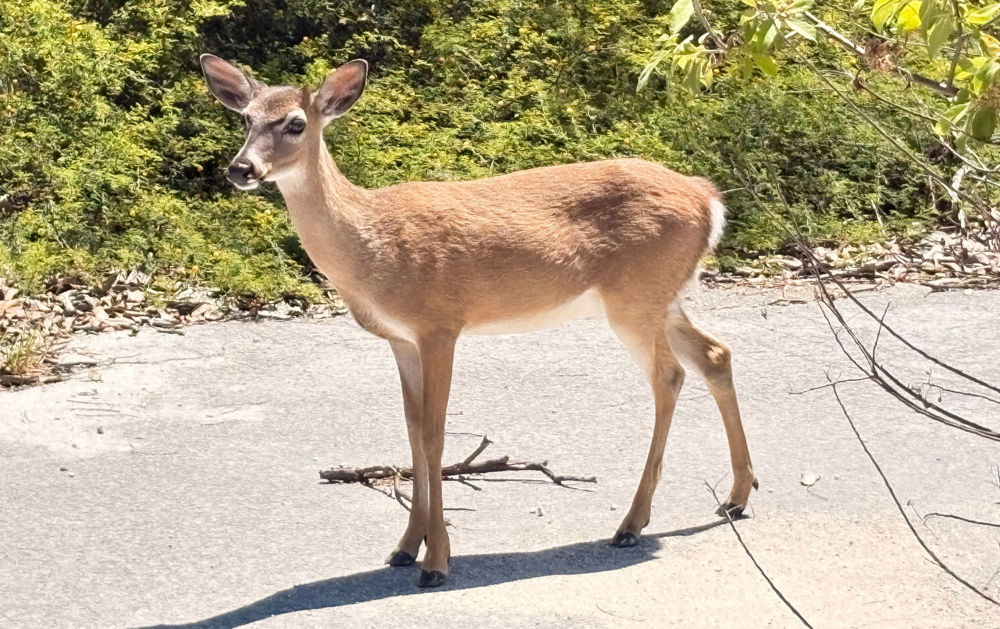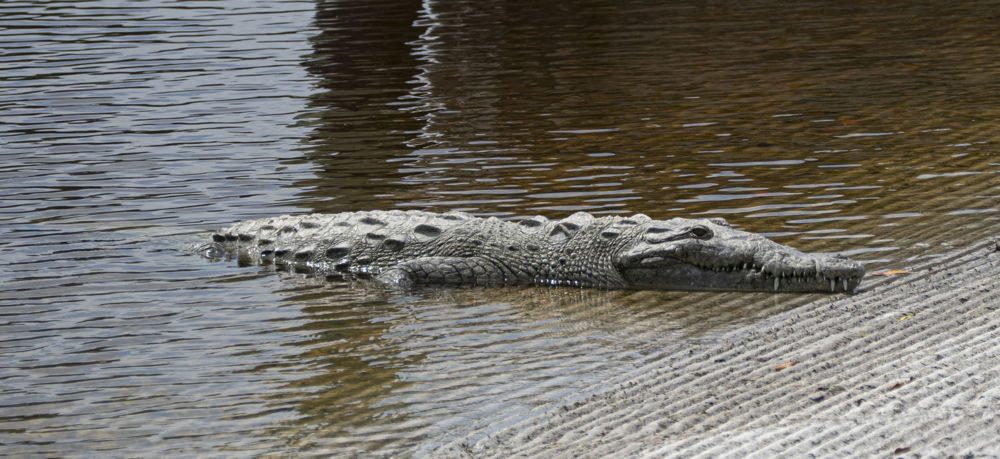Departure Date: April 19 - 27, 2025
Compiled By: Rafael Gálvez
Trip Leaders: Rafael Galvez
Toll Free: 800.328.8368
Phone: 512.328.5221
South Florida & The Keys 4/19/2025-4/27/2025

Our 2025 South Florida & The Keys tour kicked off in Key West with a downpour of migratory warblers of several species, including a vagrant Townsend’s Warbler and dozens of Cape Mays, then took us up the peninsula to find many more birds through a wide diversity of habitats, and ended back where we started with another vagrant, the highly coveted Bahama Mockingbird!
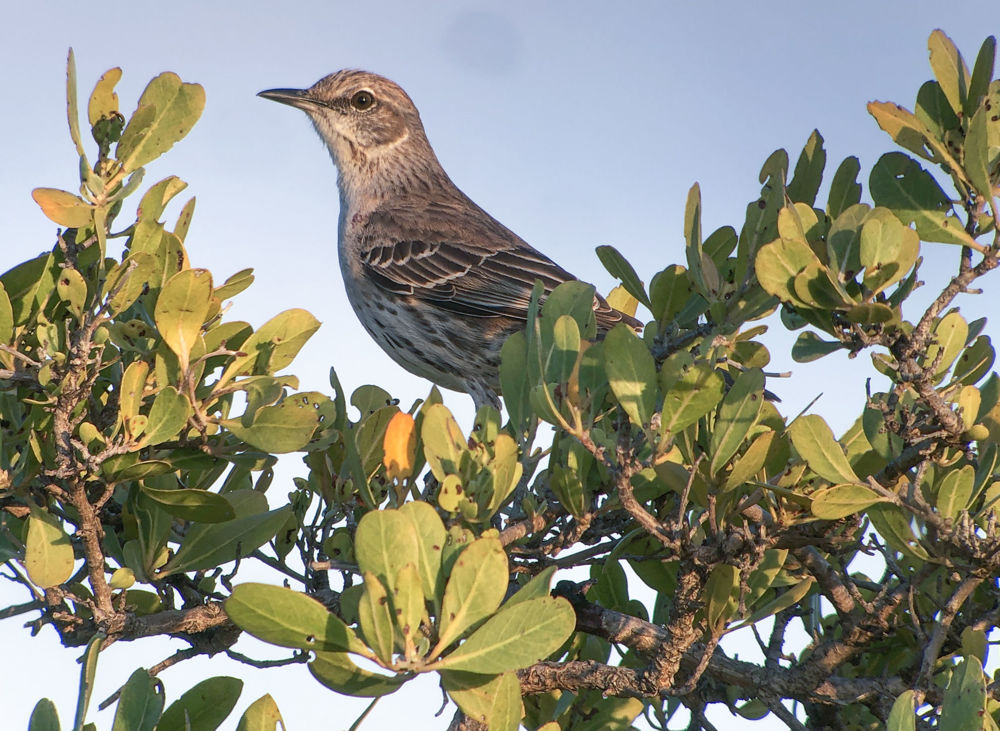
Bahama Mockingbird © Rafael Galvez
Making our rounds through a variety of native habitats, from mangrove forests to hardwood hammocks, swamps, and sawgrass prairies, we eventually found several of the challenging regional species that make South Florida so distinctive, including Gray Kingbird, Black-whiskered Vireo, White-crowned Pigeon, Mangrove Cuckoo, Antillean Nighthawk, and more. Our time spent crisscrossing the region’s suburban sprawl was also rewarding, granting us Spot-breasted Oriole, Red-whiskered Bulbul, Egyptian Goose, and six species of parakeets. Our group of adventurous birders was great fun, with many sets of sharp eyes and enthusiasm.
After leaving Key West, we set off to explore the Florida Keys, one of the continent’s hotspots for bird migration. Hopping from island to island while fine tuning our feelers for migrants, we managed to find many species. The core of the birds we saw were warblers, primarily Cape May in all its permutations, from stunningly colored adult males to drably striped younger ones. Just having arrived at our first location, Fort Zachary Taylor State Park, we had barely stepped out of the vans onto the parking lot, and the canopy over us was buzzing with birds. American Redstart, Black-and-white, Palm, Prairie, and Blackpoll were all immediately represented. However, the most surprising of them all was the vagrant male Townsend’s—potentially only the 2nd record for Key West!
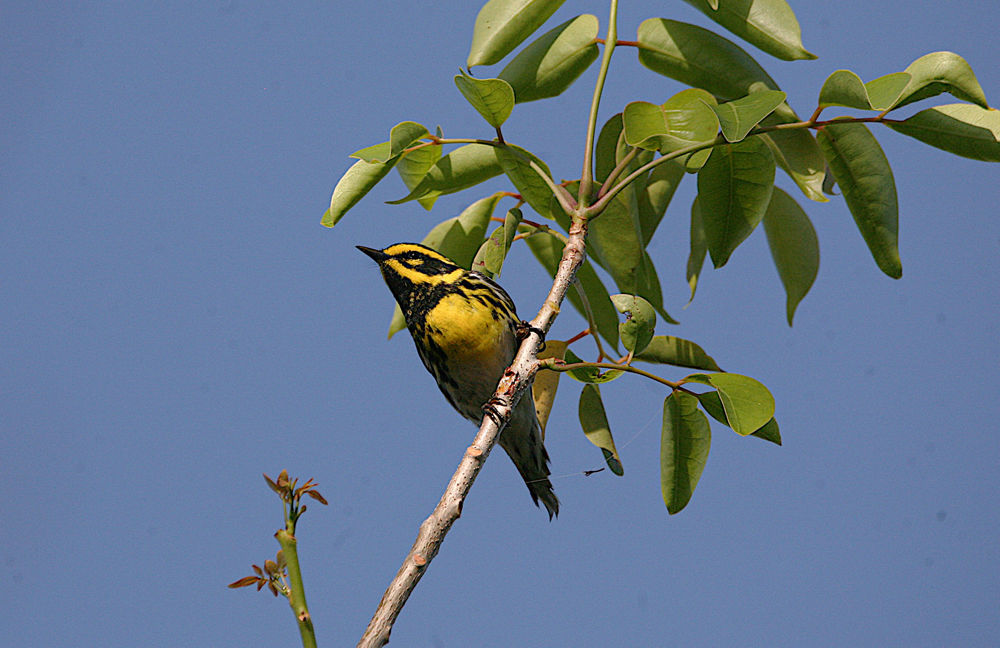
Townsend's Warbler © Cindy Baisden
Before leaving the Keys, we became acquainted with other breeding specialties, which had recently returned from wintering grounds in the Caribbean, including White-crowned Pigeon and Gray Kingbird. We scored beautifully in the Lower Keys with another Florida star, the Short-tailed Hawk, which has typically left for breeding grounds in Central Florida by this time of the year. Two flew over us at close range in the Saddlebunch Keys. At that same location we made our first of four efforts for the most challenging bird on the tour, the Mangrove Cuckoo. Surprisingly, it was apparently still early for Black-whiskered Vireos, and we’d have to wait until later on the tour to enjoy one.
The Mangrove Cuckoo is among the most sought-out birds in South Florida. Anyone taking to birding in South Florida should not expect to readily see one, unless persistence and patience are added to the mix. When we finally encountered one on the 21st, we had already tried three other locations. That day was one of contrasts, for it was divided into three chapters, taking us to very different locations that exemplified the region’s dynamics. We started off at a beautiful Red Mangrove forest along the southeasternmost point of the peninsula. Mangroves are the first line of defense against erosion and storm surges, particularly during frequent storms and hurricanes. The second part of the day led us into one of the fastest growing, most saturated, and most bustling urban corridors in the country to search for birds in Miami. The third part of the day was spent overlooking the serenity of the Sawgrass Prairie that once dominated the interior of the state.
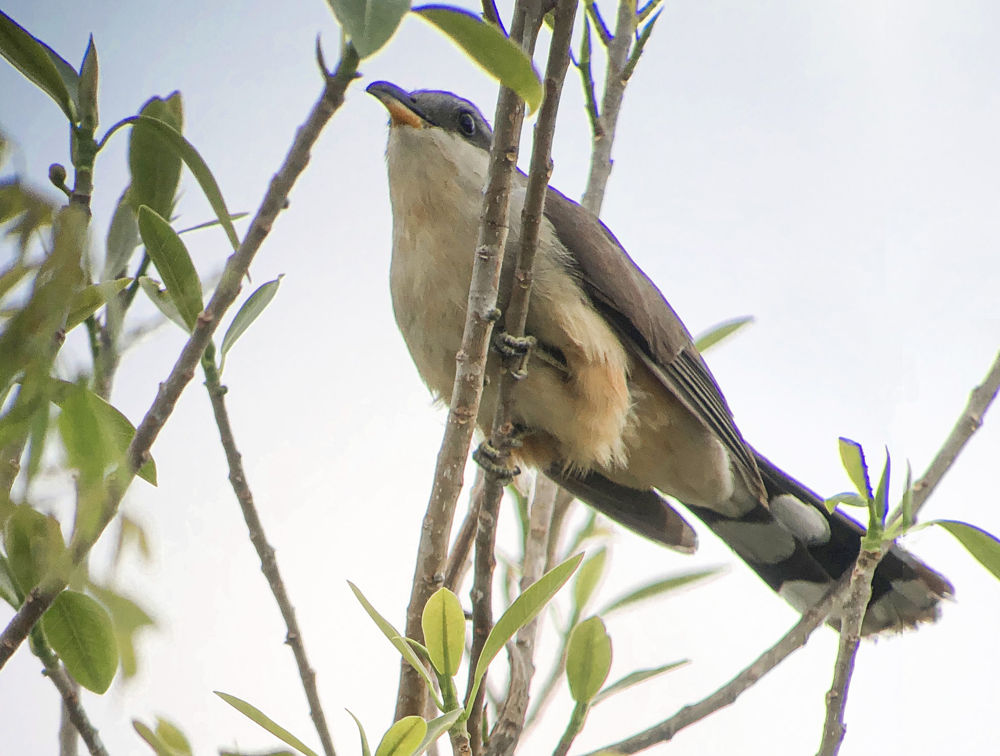
Mangrove Cuckoo © Rafael Galvez
After being ignored by Mangroves Cuckoos again, this time along Biscayne Bay, we tried deeper south along the coast at a stand of mature trees, and before long, a beautiful cuckoo came out to full view. It really could not have been a better view of this stunning, reclusive bird—and it was a lifer for many in our group! Feeling triumphant, we headed north, into neighborhoods where we found Red-whiskered Bulbuls and Spot-breasted Orioles. We then continued to the Biltmore Hotel golf course in Coral Gables where we caught up with Egyptian Geese and several species of “psittacids” including Mitred, Red-masked, Yellow-chevroned, and White-winged parakeets! Lunch was delightful in the Cuban enclave of “Calle Ocho,” at the renowned La Carreta restaurant. To top off our individual orders, we also had an assortment of appetizers including platanitos fritos, tostones, fried yuca, and the classic mamey shakes made from the delicious “marmalade tree.” We toasted to a round of coladas, the Cuban style espresso shots.
Finally, the afternoon of the 21st took us westward, on a drive down Tamiami Trail along the northern boundary of Everglades National Park towards Big Cypress, surrounded by vast expanses of Sawgrass Prairie. Raised stretches of highway allowed views of miles and miles of sawgrass prairies. We stopped to admire a slough with nearby alligators; dozens of wading birds, including Roseate Spoonbills, Wood Storks, and herons of various species; and Swallow-tailed Kites floating overhead!
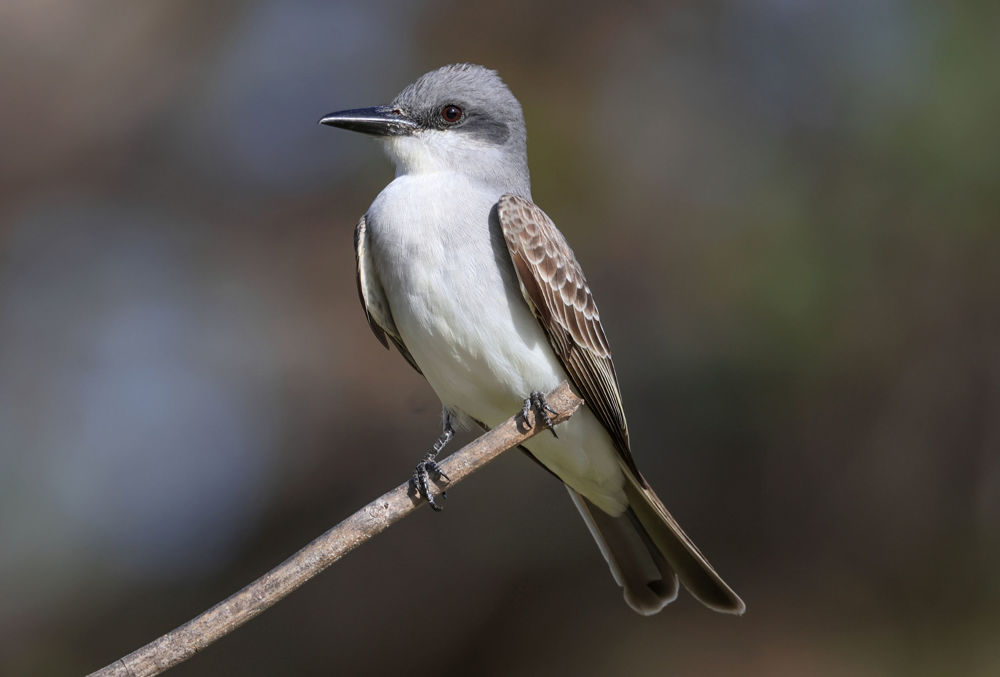
Gray Kingbird © Larry Reis
On the 22nd, the day we visited Everglades National Park, we arrived at daybreak, when the palette of subtle greens and golds over the “river of grass” glistens with the early morning light. The Everglades is indeed a place of subtleties, and there is a charm in noticing how the habitats change with the slightest shifts in elevation, from pinelands a few feet in elevation, down to freshwater sloughs and flooded cypresses, eventually giving way to brackish marshlands and the mangrove coast. Flamingo, at the end of Highway 9336, was once a remote trading post, and we drove along the campground roads, finding a Shiny Cowbird—along with their Brown-headed congeners! We also enjoyed close views of Common Ground Doves, extimus Red-shouldered Hawks, and the endangered American Crocodile. In the outskirts of the Everglades, we caught up with a White-tailed Kite, Burrowing Owls, Loggerhead Shrikes, Eastern Meadowlarks, and our third cowbird species of the day—Bronzed!
Back in the glades that evening, we visited the Pine Rocklands where we caught up with Pine Warbler, “White-eyed” Eastern Towhee, and Common Nighthawks in close views, engaged in their impressive booming displays. The best part of the evening, however, was reserved for a deeper sector of the pinelands, at a secluded fire road where we found a very territorial Chuck-will’s-widow. Like a stealthy giant moth, it put on quite a display upon finding us on his turf, grunting out loud as he circled us, and landing right before us to boastfully do a protest stomp with its puny feet, glaring at us with enormous eyes.
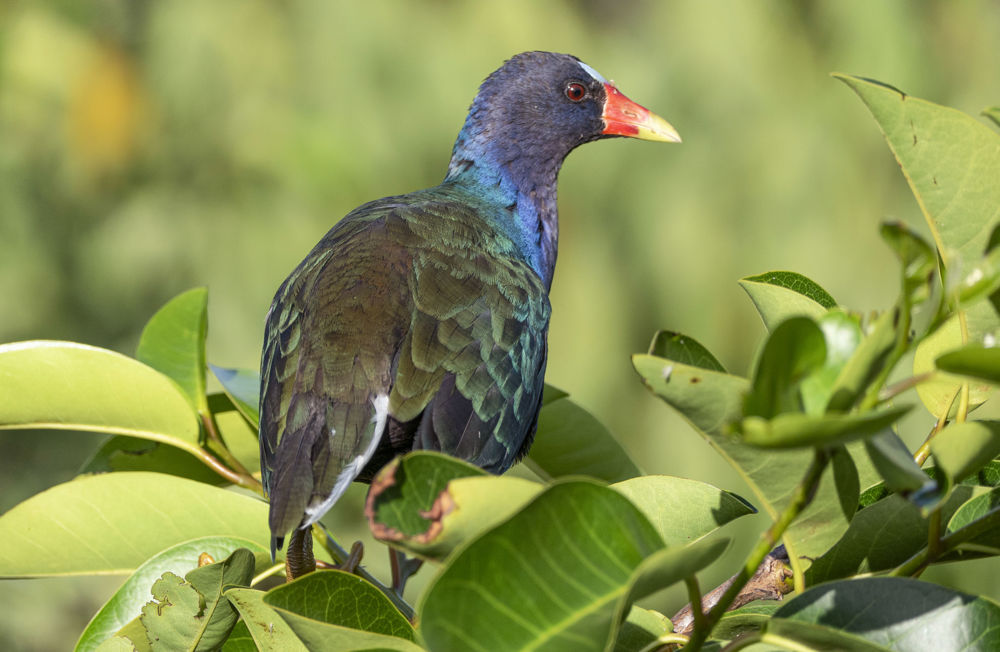
Purple Gallinule © Rafael Galvez
After leaving Homestead and Miami-Dade County, we relocated to Palm Beach, where we visited wonderful sites that were nominated as favorites of the tour. We spent one morning at the bountiful Wakodahatchee Wetlands—a set of reclaimed water facilities converted into very successful marsh colonies with boardwalks, allowing incomparably close views of nesting Wood Storks, Anhingas, Tricolored and Great Blue herons, Great and Cattle egrets, Glossy Ibises and so much more. There were so many highlights at this magical location that it is difficult to decide where to begin. The parent Wood Storks shading their fuzzy young—which made nasal begging calls—were magnetizing, and we could have spent hours watching them and the congregations of young at various stages of growth, trying their wings and learning from one another. Young Tricolored Herons and Great Egrets were at arm’s reach from the boardwalk. Mother Mottled Ducks and Common Moorhens tended to their chicks on the shallows, while the charismatic Gray-headed Swamphens foraged with their tremendous head shields and massive feet. We also found stunning Purple Gallinules and cooperatively still Least Bitterns, along with countless other species. One of the most memorable moments that day was observing two Limpkin parents with their newly hatched chick, all fuzzy and dark, doing its best to keep up with their foraging along a canal. The parents exploded into open-winged excitement when their chick managed to climb up the steep embankment along the water’s edge to join them up on the berm—they ran back to encourage it as they met at the top. Those behaviors taught a deep story and helped us recognize Limpkins as kindred with cranes.
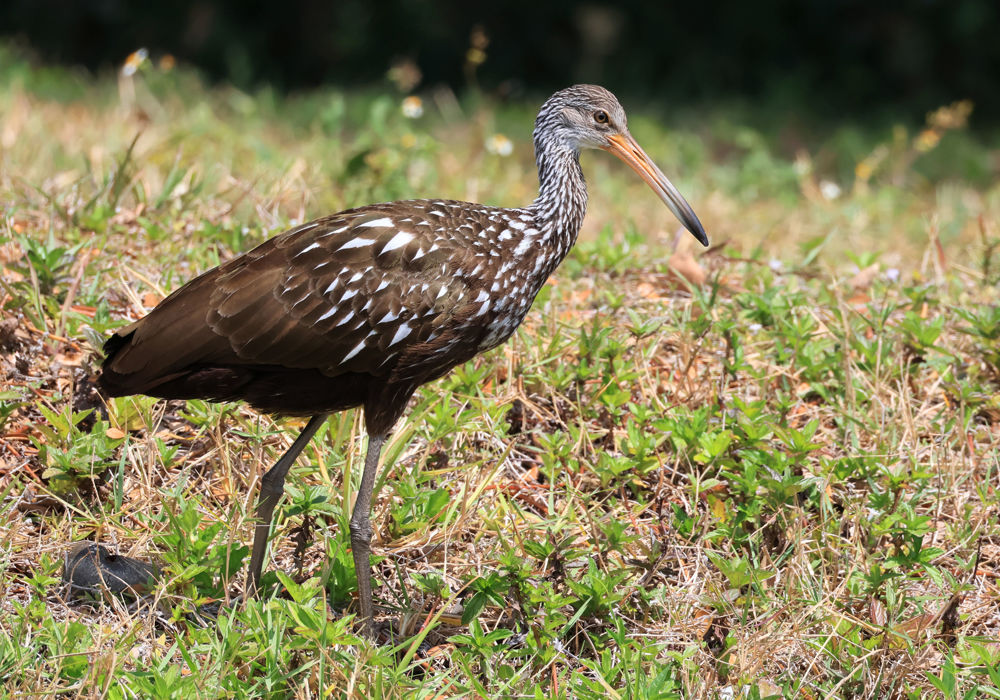
Limpkin © Larry Reis
The following morning, we continued north towards Martin County, where we visited Jonathan Dickinson State Park. This is the southernmost location along the east coast with remaining Oak Scrub habitat still inhabited by Florida Scrub-Jays, and Pine Flatwoods inhabited by Bachman’s Sparrows. Once in the flatwoods, after walking down some firebreaks, we were fortunate to hear Bachman’s Sparrows readily singing—a faint song at first that may sound similar to the Eastern Towhee to the untrained ear. After walking strategically along the beautiful Slash Pine forest with its proliferating Saw Palmetto understory, we were able to pinpoint the location of a pair of competing Bachman’s Sparrows across their territories, and were within a few feet of one bird that burst into a flourish of song!
The ”pinewoods” sparrow was a great addition to our efforts—and a new species for most of our group, so we continued optimistically to another habitat, the dune-like Oak Scrub, a quickly diminishing habitat much coveted by developers for its higher elevation and well-drained soils. Before long, we were in the midst of the state’s sole endemic avian species, the charismatic Florida Scrub-Jay—and it is so much fun to watch them go about their business in search of acorns and arthropods on the ground.
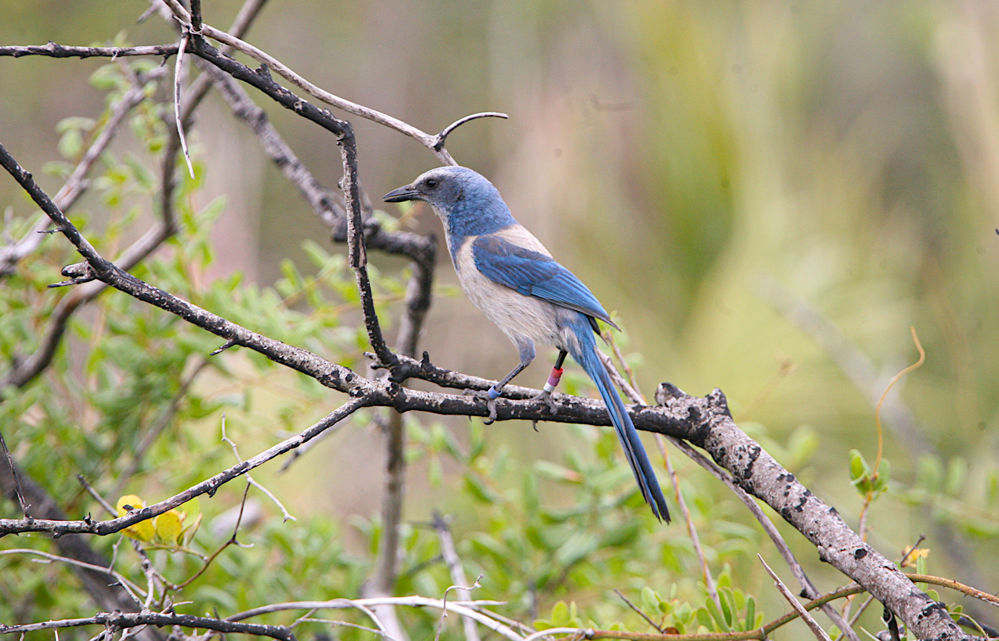
Florida Scrub-Jay © Cindy Baisden
During that afternoon, we visited Green Cay, another set of wetlands intertwined by boardwalks. Florida Softshell Turtles and Yellow-bellied Cooters abounded, while Black-bellied Whistling-Ducks and Double-crested Cormorants rested confidently along banisters as we walked by. There, we encountered many herons and gallinules of both species, but the highlights were a clutch of young Least Bitterns, and an Eastern Screech-Owl tucked into a Cabbage Palm. During our time in Palm Beach, we visited some of the tour’s most cherished locations. Included was Loxahatchee, where we saw countless herons, egrets, spoonbills, and Anhingas flying back and forth from their rookeries, as we perched atop a tower overlooking the vast glades.
After a stellar time at the northern reaches of our itinerary, it was time to return to the Keys. Not everything was bound to go perfectly, and one of our original vans started experiencing problems, so we had to rent a smaller vehicle to take us as far as Miami, where we exchanged for a larger van once again. Although we executed the exchange as expediently as possible, it did take up some of our time, and we wound up delayed in traffic.

Least Bittern nestlings © Rafael Galvez
We spent the final day of our tour traveling from the Middle Keys to Key West, stopping at various locations including Long Key and Windley Key state parks, Plantation Key Hammock Preserve, and eventually back to Fort Zachary Taylor. The bridges from key to key were great vantage points for Magnificent Frigatebirds, Royal and Least terns, and other waterbirds. The color of the water became increasingly attractive, with deep aqua and viridian hues as we traveled along. We stopped at a salt pan halfway through to catch up with Black-necked Stilts, some of which were nesting along the edges, and various other shorebirds including both species of Yellowlegs; Stilt, Least, and Semipalmated sandpipers; Short-billed Dowitchers; Black-bellied and Semipalmated plovers; and more. This turned out to be one of the best stops for the energetic Reddish Egret, which was high on the list for some in our group, and for the daunting Great White Heron, the largest of its tribe and crown jewel of the Florida Keys. We were also keen on finding a Key Deer, and as we drove through Big Pine, Sandy was quick to spot one, and we stopped to admire the friendly little mammal, symbol of the Middle Keys.
The day ended with quite the surprise! Several days earlier, while we were in the mainland, a Bahama Mockingbird had been spotted at “Fort Zach” during a brief instance. Days had gone by without a sighting, and then it had apparently been relocated earlier the day of our return. We just had to try to find it! As we birded the hammocks around the fort, we encountered birders who hadn’t succeeded in finding the vagrant from the Bahamas. There were plenty of other birds in the park, including warblers, buntings, and grosbeaks. Yet intent on finding the mockingbird, we tried something different and visited a hammock on the northern end of the park. Soon after winding our way through, the Bahama Mockingbird popped out from the treetops and found an excellent perch for us to admire it at length—only minutes before sundown on our final day. We couldn’t have asked for a grander finale!
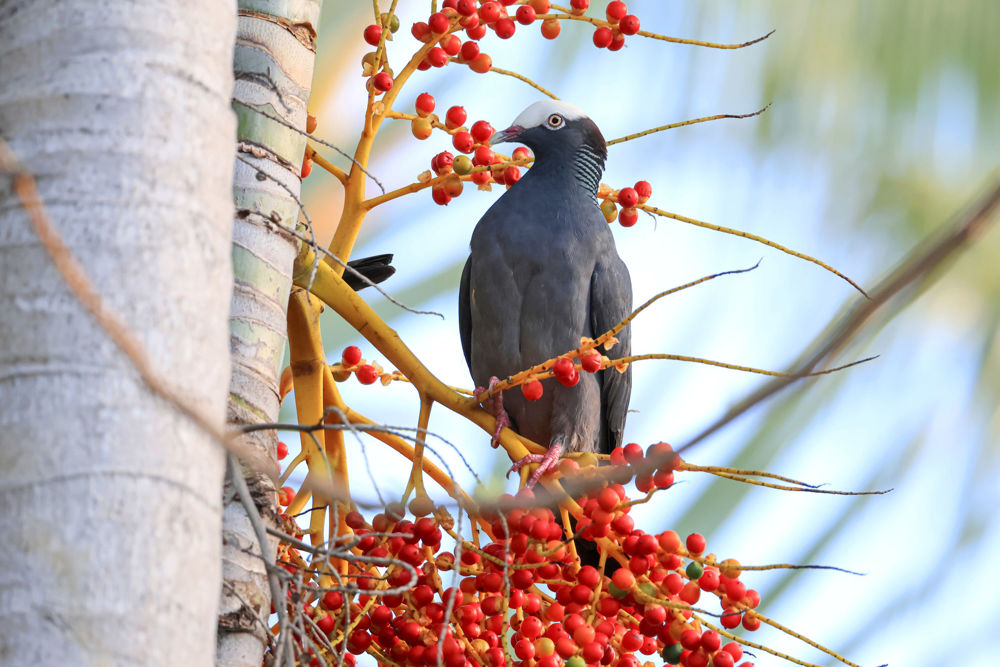
White-crowned Pigeon © Larry Reis
During our final dinner in Old Key West, we celebrated our journey through this region of contrasts, where preserved wilderness remains against the sprawl of urban development, offering an unparalleled diversity of birding opportunities. We celebrated many wildlife encounters, some of which contributed to a birding milestone, as Ida reached 600 ABA lifers during the tour. We also celebrated Suzi’s birthday during the tour, while we gathered as friends new and old, hoping to meet once again soon for another birding adventure.
VOTED FAVORITES BY OUR GROUP:
- Florida Scrub-Jay
- Green Cay and Wakodahatchee
- Bachman’s Sparrow
- Spot-breasted Oriole and Red-whiskered Bulbul
- Chuck-will’s-widow
- White-crowned Pigeon
- Burrowing Owl
- Bahama Mockingbird
- Mangrove Cuckoo
- Red-masked Parakeet
Honorable mentions: The nesting colony at Wakodahatchee, particularly for the close proximity to nestling Wood Storks and herons. The Mangrove Cuckoo is always an incredible bird to find! The Townsend’s Warbler was only the 2nd ever photographed in Key West! Cape May Warblers were ubiquitous and stunning!
A complete list of the birds recorded on our trip can be found at:
https://ebird.org/tripreport/373244
View Rafael Galvez's upcoming tour schedule.
ITINERARY:
April 19 – Once in Key West, our group met at the Doubletree Grand Key Resort at 5 p.m. After a nice oceanside dinner at La Trattoria, we headed to Boca Chica Beach for some sunset birding. We spent the night in Key West, at the DoubleTree Grand Key Resort.
April 20 – After breakfast and with our bags packed into the van, we started our journey northeastward through the Keys, stopping first at Fort Zachary Taylor State Park. We then visited the Saddlebunch Keys along Sugarloaf Blvd. We then had lunch in Marathon at the Island Fish Company. Afterward, we stopped at a productive location for waders and shorebirds in Grassy Key, followed by Plantation Key Hammock Preserve. After checking in at the TownePlace Suites in Homestead, we went to dinner. We spent the night in Homestead.
April 21 – After an early breakfast at Sam’s Country Kitchen, we left for a visit to Biscayne National Park for Mangrove Cuckoo. We then left Homestead northward and entered Miami through the Kendall neighborhood where we searched successfully for bulbuls at King’s Creek. From there we continued to the Biltmore Hotel Golf Course in search of parrots. After lunch at La Carreta Cuban restaurant, we headed west on Tamiami Trail towards Big Cypress National Preserve, driving along the northern boundary of Everglades National Park, reaching our westernmost destination nearly halfway across the peninsula. We made a stop in the Westchester area for Spot-breasted Orioles before returning to Homestead, we had dinner at Bangkok Cuisine. We spent the night in Homestead.
April 22 – After an early breakfast at Sam’s Country Kitchen, we started into Everglades National Park and the Pa-Hay-Okee region west of Mahogany Hammock. We continued making stops along Hwy. 9336 towards the old outpost of Flamingo, the campgrounds and marina. We left the park for lunch at the lovely White Lion Cafe. After a mid-afternoon rest, we visited the regional airport, and found Burrowing Owls. Back in the Everglades, we saw the Pine Rockland specialties including Pine Warbler. At the crepuscular hour, we visited the domain of Chuck-will’s-widows. We returned to Homestead for the night.
April 23 – We left Homestead with bags packed towards Palm Beach County, arriving to the impressive nesting colonies at Wakodahatchee Wetlands. Lunch was at the excellent Prime Catch in Boynton Beach, followed by an early check in at the TownePlace. After a mid-afternoon rest, we visited Loxahatchee National Wildlife Refuge, visiting the boardwalk, and the overlook tower by the canal. Dinner was Agliolio Italian restaurant. The night in Boynton Beach.
April 24 – We left northward to Martin County to visit Jonathan Dickinson State Park where we spent time in Scrub Oak and Pine Flatwoods in search of Florida Scrub-Jays and Bachman’s Sparrows. We stopped at Pine Glades for a Caracara before lunch. In the afternoon we visited the Green Cay Nature Center back in Boynton Beach for a beautiful sunset in the marsh. Dinner was at the wonderful Driftwood Restaurant. We spent the night in Boynton Beach.
April 25 – We left Boynton Beach with our luggage loaded after breakfast at the hotel, and visited Loxahatchee NWR one more time. We then stopped at the Fran Reich Preserve. We then continued south to Miami-Dade County, for lunch. We continued traveling south into the Florida Keys, eventually stopping at the Marathon Airport for sundown. We spent the night in Marathon.
April 26 – Already in the Keys, we visited Long Key and Windley Key state parks this morning. After lunch in Lazy Days Islamorada, we continued towards Key West and checked into the DoubleTree resort. After a brief rest, we went directly to Fort Zachary Taylor SP, where we spent quite some time enjoying the migratory songbirds - eventually finding the Bahama Mockingbird. We capped the night with our final dinner at First Flight Restaurant and returned to the Doubletree Grand Key Resort.
April 27 – Departures back home for those not continuing to the Dry Tortugas extension.
Note: Species in underlined print are of limited distribution in the region, and/or ABA countable only in this region, or are otherwise generally hard to find. Species in bold and underlined print are vagrants, or very rarely seen in the region. ( I ) indicates introduced species. ( E ) indicates endemic to the region.

Wood Stork colony © Rafael Galvez


